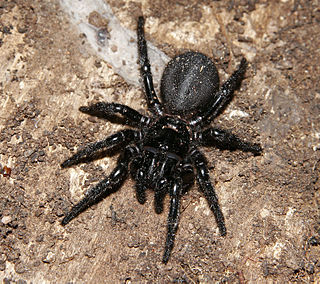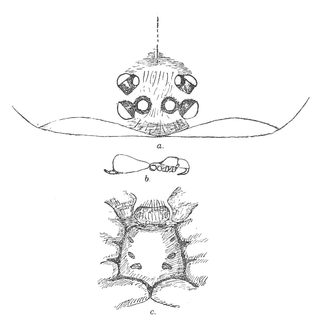
The Mygalomorphae, or mygalomorphs, are an infraorder of spiders, and comprise one of three major groups of living spiders with over 3,000 species, found on all continents except Antarctica. Many members are known as trapdoor spiders due to their creation of trapdoors over their burrows. Other prominent groups include Australian funnel web spiders and tarantulas, with the latter accounting for around one third of all mygalomorphs.

Hexathelidae is a family of mygalomorph spiders. It is one of a number of families and genera of spiders known as tunnelweb or funnel-web spiders. In 2018, the family was substantially reduced in size by genera being moved to three separate families: Atracidae, Macrothelidae and Porrhothelidae.

Hadronyche is a genus of venomous Australian funnel-web spiders that was first described by L. Koch in 1873. Originally placed with the curtain web spiders, it was moved to the Hexathelidae in 1980, then to the Atracidae in 2018.

Nemesiidae, also known as funnel-web trapdoor spiders, is a family of mygalomorph spiders first described by Eugène Simon in 1889, and raised to family status in 1985. Before becoming its own family, it was considered part of "Dipluridae".

Idiosoma is a genus of Australian armoured trapdoor spiders that was first described by Anton Ausserer in 1871. Originally placed with the Ctenizidae, it was moved to the armoured trapdoor spiders in 1985. The name is derived from the Greek ἴδιος, meaning "individual, unique", and σῶμα, meaning "body", referring to the distinctive structure of the abdomen.

Aname is a genus of mygalomorph spiders. It is endemic to Australia. The spiders, as well as some in closely related genera, are also known as wishbone spiders.

Porrhothele is a genus of mygalomorph spiders endemic to New Zealand. They are the only members of the family Porrhothelidae. They were first described by Eugène Louis Simon in 1892. Originally placed with the curtain web spiders, it was moved to the Hexathelidae in 1980, they were placed in their own family in 2018.

Cantuaria is a genus of South Pacific armored trapdoor spiders that was first described by Henry Roughton Hogg in 1902. From 1985 to 2006 it was merged with former genus Misgolas, now Arbanitis.
Cataxia is a genus of Australian armoured trapdoor spiders that was first described by William Joseph Rainbow in 1914.
Euoplos is a genus of armoured trapdoor spiders that is endemic to Australia. It was first described by William Joseph Rainbow in 1914.

Acanthogonatus is a genus of South American mygalomorph spiders in the family Pycnothelidae. It was first described by Ferdinand Anton Franz Karsch in 1880. Originally placed with the brushed trapdoor spiders, it was transferred to the funnel-web trapdoor spiders in 1985, then to the Pycnothelidae in 2020.
Entypesa is a genus of African mygalomorph spiders in the family Entypesidae. It was first described by Eugène Louis Simon in 1902. Originally placed with the curtain-web spiders, it was transferred to the funnel-web trapdoor spiders in 1985, then to the Entypesidae in 2020. It is a senior synonym of Pseudohermacha.
Kwonkan is a genus of Australian mygalomorph spiders first described by Barbara York Main in 1983. It was originally assigned to Dipluridae, but was later assigned to Nemesiidae due to similarities to the genus Aname, before being transferred to the family Anamidae in 2010. The known distribution of described species in the genus is restricted to the states of South Australia (SA) and Western Australia (WA). Yilgarnia is now considered a synonym for this genus, and its type species is assigned to Kwonkan currycomboides.
Pionothele is a genus of African mygalomorph spiders in the family Pycnothelidae. It was first described by William Frederick Purcell in 1902. As of June 2020 it contains 2 species, found in Namibia and South Africa: P. gobabeb, and P. straminea. Originally placed with the Ctenizidae, it was transferred to the funnel-web trapdoor spiders in 1985, then to the Pycnothelidae in 2020.
Pycnothelidae is a family of mygalomorph spiders first described in 1917. It was downgraded to a subfamily of the funnel-web trapdoor spiders in 1985, but returned to family status in 2020.

Crassitarsae is a clade of avicularioid mygalomorph spiders first proposed by Robert J. Raven in 1985, based on a morphological cladistic analysis. Raven characterized the clade by a number of shared features, including the presence of some scopulae on the tarsi. The clade has been supported to some degree by subsequent molecular analyses, although with a somewhat different composition.

Nemesioidina is a clade of avicularioid mygalomorph spiders proposed in 2020, based on a molecular phylogenetic analysis.
Arbanitis montanus is a species of armoured trap-door spider in the family Idiopidae, and is endemic to New South Wales.
Stanwellia inornata is a species of mygalomorph spider in the Pycnothelidae family. It is endemic to Australia. It was described in 1972 by Australian arachnologist Barbara York Main.











